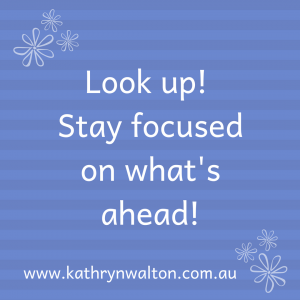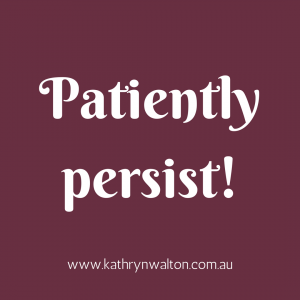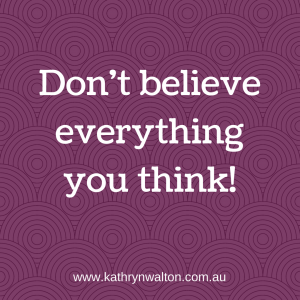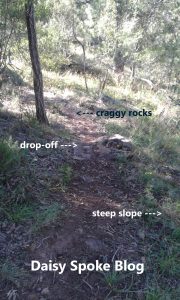What do bush adventure therapy and deep listening have to do with me? Well, here’s my story…..
Last week I really struggled. Everything seemed heavy and I simply wasn’t motivated to do many of the tasks I usually do each day. I know exactly why this happened, and with hindsight it all makes sense. But honestly, I did not see it coming until it hit me.
The Power of a Fantastic Conference
I blame it all on the AABAT (Australian Association for Bush Adventure Therapy Inc) conference that I’d been to the week before. After all the anxiety leading up to the conference and the pre-conference expedition, I never imagined having a more awe-inspiring experience surrounded by the friendliest, most welcoming, positive yet realistic people I’ve ever had the privilege of being with. After nearly a week spent camping, hiking, conferencing and in deep listening with the natural world around me, I found myself back at work surrounded by painted walls in the midst of the worst drought on record and isolated from my new-found tribe of bush adventure therapists.
Connection to Land, People and Myself
I sense that the lush and rugged terrain surrounding me while I was at the conference was also my protector and connector. Having heard some of the stories held by this land, I felt like I became part of it and part of the stories to be told in the future. Incredible things happen when we connect with nature and with each other. We come to know ourselves. We learn the art of deep listening, feeling and responding.
At the conference I learned bucketloads about the science of sensory awareness, the future for social work in bush adventure therapy, healing trauma, writing grant applications for projects, and the value of story-telling. I discovered the real-life stories where bush adventure therapy had made a difference in the lives of people including women following domestic violence, young people in the care and protection and justice systems, and people wanting to rediscover who they are and what life is all about.
With over 170 people at the conference, I wasn’t going to have the opportunity to meet and get to know everyone. But the real treasure for me was going on the pre-conference expedition when I spent a couple of days and nights with a beautiful group of adventurists as we challenged ourselves with plenty of uphills and downhills (READ: very-steep-scrambly-sliding-on-your-butt downhills), navigating the terrain the best we could, and giving each other a practical hand and oodles of encouragement. So by the time we rocked up to the conference venue ever so weary and dusty and sweaty, I never felt alone or isolated. I had the beginnings of my tribe. And with this sense of belonging and connection, my confidence and comfort grew.

CREDIT: AABAT
Coming Home and The Aftermath
All these things I held gently in my heart as I made my way home after the conference, excited for all the wonderful projects across the globe that connect people to nature, and super-excited for the part that I hope to play in the future. Full of stories and inspiration, I joyfully shared the highlights with anyone I came across.
And then unexpectedly it hit me. With the realisation that I was back to the ‘same-old same-old’ I felt the slump growing bigger as I listed off all the things I ‘should’ be doing but wasn’t. My yearning to be outside was incredibly strong, but I ‘should’ go back in and answer those emails and phone messages. I wanted to scream out that it’s not fair it’s so dry here and so green somewhere else, but I thought I ‘should’ just get on with life and stop comparing. And I wanted to be surrounded by my comrades even though I ‘should’ be grateful that I get to work for myself.
Life Goes On – Struggles Included
Here I am at the start of another week, still spurred on by everything bush adventure, still struggling somewhat. And I think to myself “How human am I? How human is it to feel the struggle?” We all have struggles even when life is going well. And from the struggle, when we can step back and look at it with love and support, comes strength, inner knowing, and intentional action.
Bush Adventure Therapy and Deep Listening
That’s what I’m working on this week. Identifying my strengths and especially what I’ve come to discover over the past couple of weeks. Finding that place deep in my heart that knows what I need to do, and being able to trust it to guide my way forward. Deep listening with the land and all that it nurtures (even in drought), deep listening with my community. And deep listening with myself.
That’s what bush adventure therapy means for me – deep listening to land, others and self. Belonging. Connection. Trust.

Discovering mountain biking as life’s ultimate parallel universe in her middle age, Kathryn Walton shares information and reflections in ‘Daisy Spoke’ that inform, inspire and empower women to a healthy and active lifestyle.







 So first of all, make sure you GET THE BIG ROCKS IN YOUR LIFE FIRST. They are your priorities so take steps to make sure you allow plenty of time and energy for them. Next put in your medium-sized rocks. Your small rocks go in after that and will be able to settle into the spaces between the bigger rocks. You can be more flexible with how they fit into your life. Next comes the sand. These things will be able to flow into the spaces that you have left. If there isn’t time and energy for them right now, that doesn’t matter. When things settle, they’ll have a place in your bucket once again.
So first of all, make sure you GET THE BIG ROCKS IN YOUR LIFE FIRST. They are your priorities so take steps to make sure you allow plenty of time and energy for them. Next put in your medium-sized rocks. Your small rocks go in after that and will be able to settle into the spaces between the bigger rocks. You can be more flexible with how they fit into your life. Next comes the sand. These things will be able to flow into the spaces that you have left. If there isn’t time and energy for them right now, that doesn’t matter. When things settle, they’ll have a place in your bucket once again. 

 Daily exercise and general physical activity are crucial elements of feeling good. Just as some people might need to diligently take medication every day, I need to exercise every day. Exercise is nature’s way of stimulating the hormones which aid concentration, problem-solving, sleep, digestion, and mood. This daily dose of exercise rebalances our body’s systems resulting in wide-ranging benefits that no single medication can provide. The research is absolutely clear that regular medium to high intensity exercise can have a profound effect on health AND happiness.
Daily exercise and general physical activity are crucial elements of feeling good. Just as some people might need to diligently take medication every day, I need to exercise every day. Exercise is nature’s way of stimulating the hormones which aid concentration, problem-solving, sleep, digestion, and mood. This daily dose of exercise rebalances our body’s systems resulting in wide-ranging benefits that no single medication can provide. The research is absolutely clear that regular medium to high intensity exercise can have a profound effect on health AND happiness.
 Minds are such complex things! They wield a lot of power over our emotions and our actions (including sleep). But unless you notice what’s going on in your mind, and choose how much power to give it, your thoughts, assumptions and beliefs will control you instead of the other way around. The habit of being hooked by thoughts or strongly attached to them is limiting and anxiety-provoking. The key here is to begin by simply noticing what is happening in your mind, and by doing this with curiosity and without judgement. The power is in the noticing. You’ll collect all sorts of interesting bits of information about how your mind works, what thinking patterns it gets locked into, what beliefs and assumptions are behind it all, and how all of this impacts your physiology, your behaviours and your emotions. One of my favourite sayings is “Don’t believe everything you think!” because we can learn to stand back, notice the thought and choose whether to believe it, or not.
Minds are such complex things! They wield a lot of power over our emotions and our actions (including sleep). But unless you notice what’s going on in your mind, and choose how much power to give it, your thoughts, assumptions and beliefs will control you instead of the other way around. The habit of being hooked by thoughts or strongly attached to them is limiting and anxiety-provoking. The key here is to begin by simply noticing what is happening in your mind, and by doing this with curiosity and without judgement. The power is in the noticing. You’ll collect all sorts of interesting bits of information about how your mind works, what thinking patterns it gets locked into, what beliefs and assumptions are behind it all, and how all of this impacts your physiology, your behaviours and your emotions. One of my favourite sayings is “Don’t believe everything you think!” because we can learn to stand back, notice the thought and choose whether to believe it, or not.

 After much soul searching, I made the commitment to myself that I was going to conquer the fear that had irrationally built up in my mind. I really wanted to take charge of my fearful thoughts which seemed to be controlling my actions. It was as if my own thoughts were bullying me. The longer it went on, the worse it became. I knew that if I could get this sorted, I’d be able to transfer the skills and processes to other situations that make me nervous and better manage them as well.
After much soul searching, I made the commitment to myself that I was going to conquer the fear that had irrationally built up in my mind. I really wanted to take charge of my fearful thoughts which seemed to be controlling my actions. It was as if my own thoughts were bullying me. The longer it went on, the worse it became. I knew that if I could get this sorted, I’d be able to transfer the skills and processes to other situations that make me nervous and better manage them as well.



 Read my
Read my